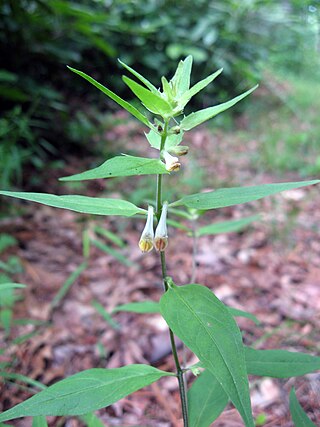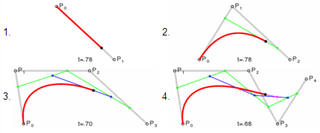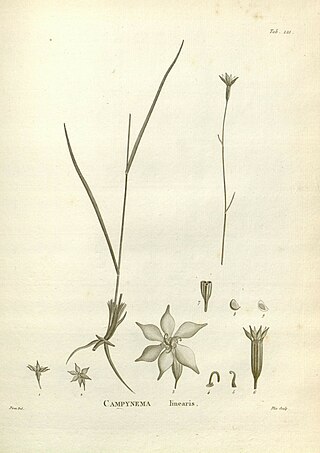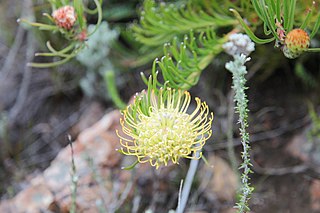Related Research Articles

Ferdinand Georg Frobenius was a German mathematician, best known for his contributions to the theory of elliptic functions, differential equations, number theory, and to group theory. He is known for the famous determinantal identities, known as Frobenius–Stickelberger formulae, governing elliptic functions, and for developing the theory of biquadratic forms. He was also the first to introduce the notion of rational approximations of functions, and gave the first full proof for the Cayley–Hamilton theorem. He also lent his name to certain differential-geometric objects in modern mathematical physics, known as Frobenius manifolds.

Melampyrum lineare, commonly called the narrowleaf cow wheat, is an herbaceous plant in the family Orobanchaceae. It is native to North America, where it is found in southern Canada and the northern United States, with an extension south in the Appalachian Mountains. It has a wide habitat tolerance, but is usually found in drier and somewhat exposed woodlands.

Sedum lineare also known as carpet sedum, needle stonecrop or sea urchin, is a sedum originating in East Asia.

Ludwig Schlesinger, was a German mathematician known for the research in the field of linear differential equations.

In mathematics, the variation diminishing property of certain mathematical objects involves diminishing the number of changes in sign.

Allium lineare is a Eurasian species of wild onions with a wide range extending from France to Mongolia.
Xanthophyllum lineare is a tree in the family Polygalaceae. The specific epithet lineare is from the Latin meaning "line", referring to the linear shape of the leaves.
Emphytoeciini is a tribe of longhorn beetles of the subfamily Lamiinae. It was described by Lacordaire in 1872.

Campynema is a genus in the family Campynemataceae first described in 1805. It contains only one known species (monotypic), Campynema lineare, endemic to the island of Tasmania in Australia. Its closest relative is Campynemanthe, endemic to New Caledonia, sole other genus of the family.
Itheum is a genus of longhorn beetles of the subfamily Lamiinae, containing the following species:
Itheum alboscutellare is a species of beetle in the family Cerambycidae. It was described by Stephan von Breuning in 1940. It is known from Australia.
Itheum fuscoantennale is a species of beetle in the family Cerambycidae. It was described by Stephan von Breuning in 1943. It is known from Australia.
Itheum robustum is a species of beetle in the family Cerambycidae. It was described by Oke in 1932. It is known from Australia.
Itheum vittigerum is a species of beetle in the family Cerambycidae. It was described by Francis Polkinghorne Pascoe in 1864. It is known from Australia.
Leonardo D'Imporzano is an Italian free-diver, an AIDA International Judge, underwater journalist, researcher conservationist, and TV personality. Pioneer of freediving under ice, he achieves the best performance under ice in Dynamic without fins at Smeraldo Lake in Val di Non 24 February 2008 with 43 metres.
Eosentomon lineare is a species of proturan in the family Eosentomidae. It is found in Southern Asia.

Leucospermum lineare is an evergreen shrub with linear leaves and is assigned to the Proteaceae. There are two distinct forms that have not been formally recognized as separate taxa. There is an upright form with orange flower heads of up to 2 m (6.6 ft) high, and a sprawling form of 2–3 m (6.6–9.8 ft) in diameter with yellow flower heads. Its common name is needle-leaf pincushion, or narrow-leaf pincushion, in English and smalblaarspeldekussing in Afrikaans. The orange-flowered form is called tangerine pincushion or assegaaibos pincushion. Flowering occurs in the first half of the southern hemisphere season, but peaks in September and October. It is an endemic species that can only be found in the southwest of the Western Cape province of South Africa.
Chryseobacterium lineare is a Gram-negative, rod-shaped, aerobic and non-motile bacterium from the genus Chryseobacterium which has been isolated from freshwater from Zhejiang in China.
Angelika Bunse-Gerstner is a German mathematician specializing in numerical linear algebra and control theory.
Lasiopetalum lineare is a species of flowering plant in the family Malvaceae and is endemic to the south-west of Western Australia. It is an erect shrub with densely hairy young stems, linear leaves and bright pink and dark red flowers.
References
- ↑ BioLib.cz - Itheum lineare. Retrieved on 8 September 2014.